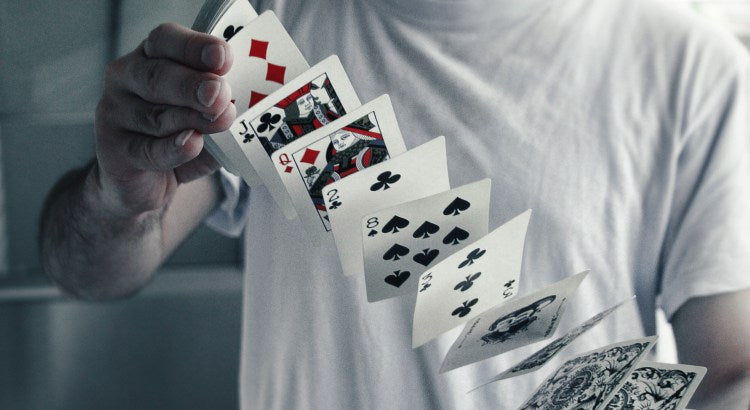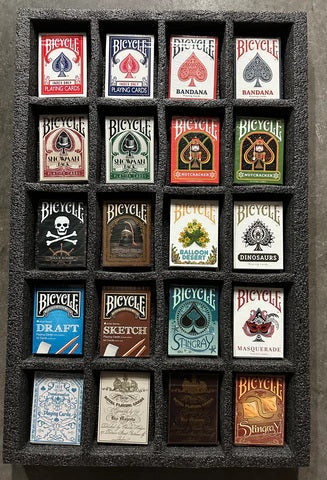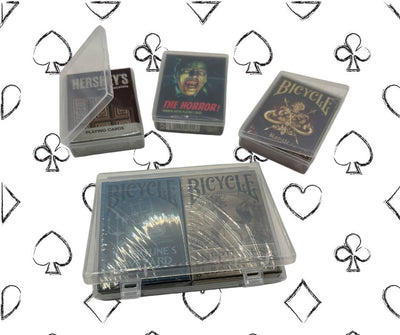Part 2: Non-Bicycle Playing Cards
Most creators of custom playing cards today choose to print their decks with United States Playing Card Company (USPCC), makers of the famous Bicycle brand of playing card. USPCC is a well-known publisher with solid credentials, and has a long history and positive reputation for creating quality playing cards. In previous articles we have covered the process by which Bicycle playing cards are made, why it's worth the money to get a Bicycle deck, and what factors affect their handling.But USPCC doesn't produce perfect playing cards. Their decks are often printed in high volume on a web press, and one disadvantage of this process is that the print registration can be slightly off, creating slightly misaligned borders. We've probably all seen decks like this, and it can be disappointing to receive a deck that has this issue.
The good news is that this issue is typically a rarity when decks are printed on a sheet-fed press, which is the printing method used by most of the competition, which typically produces runs of playing cards in lower volumes. As a result several reputable publishers have emerged in recent years that offer an excellent alternative to the industry giant of USPCC, and many of them have already earned for themselves a solid reputation for producing consistently high quality playing cards.
The first of these is Expert Playing Card Company (EPCC), which is based in Taiwan. EPCC often works in tandem with Legends Playing Card Company (LPCC), and even uses the same facilities and factories, so we'll take these two together and refer to them as LPCC/EPCC. The second of these is Cartamundi, which is based in Belgium. Along with Bicycle cards, these are arguably the key players that are at the top of the industry right now, and are producing the highest quality playing cards today. But what you need to know is: how are their playing cards made differently from Bicycle decks, and how does this affect their handling? Let's find out!
Legends and Expert Playing Cards
StockThe stock refers to the paper used to print the playing cards. LPCC/EPCC has a slightly different approach to this than USPCC, which typically uses either Bee stock (thicker), Bicycle stock (normal), or Thin Crush stock (thinnest and softest). Instead, LPCC/EPCC sources their paper from overseas, and this paper stock comes pre-embossed from their suppliers. As a result, LPCC/EPCC uses a single name that doesn't distinguish between their embossing and their stock. They both offer several four main "finishes", all of which feel and handle differently: Diamond/Master Finish, Classic Finish, Elite/Damask Finish, and Emerald/JN Finish. These are really just different combinations of paper stock and embossing, and the main differences between these "finishes" has to do with the type of paper and embossing used. These different paper stocks not only vary in thickness and firmness, but are also embossed to varying depths, making each unique in terms of how they handle. The Classic Finish and Elite/Damask Finish use the thickest paper stock, while the Diamond/Master Finish uses a thinner stock. The Emerald/JN Finish is thinner yet, and represents LPCC/EPCC's efforts to replicate the feel and handling of the Jerry's Nugget Casino cards from the '70s, which were considered legendary for their performance.
Decks produced by LPCC/EPCC in their Classic Finish and Elite/Damsk Finish are the most similar to a standard USPCC deck, and have a relatively soft and papery feel. In contrast, decks with their Diamond/Master finish have thinner cards, while decks with their Emerald/JN Finish are 0.01mm thinner still. Unlike the Thin-Crush stock from USPCC, these thinner cards from LPCC/EPCC are amazingly hardy/durable, and have a real spring and pleasing snap to them, with a surprisingly stiffer feel than the Classic Finish decks.
Texture
The texture refers to the embossed surface of a playing card. While you won't notice significant differences in embossing with USPCC produced decks, the different "finishes" of LPCC/EPCC produced decks do have different types of embossing, both in terms of the pattern and the depth used. The Diamond/Master Finish and the Emerald/JN Finish decks are the least-embossed paper stock, and that makes these cards feel somewhat oily and plastic-like. Yet these decks are also their stiffest and longest lasting cards, since these cards have a real spring to them, and prove very hardy and durable. Their Classic Finish decks have a deeper embossing pattern that the most similar to Bicycle's "Air Cushion Finish". As a result, it feels softer, and has an overall feel that is arguably closest to a Bicycle-type deck from USPCC. The deeper the embossing, the softer the cards will feel, so while the Elite/Damask Finish decks use a similar paper stock to the Classic Finish, a different and deeper embossing pattern on these cards makes them feel even softer yet. In practice, this means that a deck of custom playing cards by USPCC will feel most similar to LPCC/EPCC's Classic Finish. In contrast, LPCC/EPCC's Diamond/Master Finish and Emerald/JN Finish deck are noticeably stiffer and also feel more "tacky", making them more ideal for moves and sleights like springs, cuts, and even double lifts.
Coating
The coating refers to a protective finish added at the end of the printing process, to protect the cards and make them slide over each other smoothly and evenly. LPCC/EPCC uses the same coating for all their card stocks/finishes, although they are constantly experimenting with their coating formula to improve it. Like the Magic Coating used on Bicycle decks, the aim of this coating is that it combines with the embossing to create the perfect amount of drag, slip, as well as durability. LPCC/EPCC's coating tends to be sightly less slippery than those of USPCC produced decks. In my experience, the coating on USPCC produced decks tends to wear out more quickly, meaning that your cards won't spread or fan as evenly over time. In contrast, LPCC/EPCC produced decks have a coating that seems to be harder wearing, slightly less slippery, and they seem to perform consistently for a longer period of time. But this is not always true - while most LPCC/EPCC decks are produced in their factory in Taiwan with a consistent level of quality, watch out for decks produced with their JN Finish in China - these don't seem to be as good, and these cards tend to clump much more quickly.
Cut
The cut refers to the direction of the bevelled edge of the cards, and affects the direction in which cards can be faroed or weave shuffled together. LPCC/EPCC decks are all given a traditional cut (face to back) rather than the modern cut (back to face) that is used as a standard by USPCC. Their cutting process also involves a Diamond Cut technique that produces a much smoother cut than UPSCC. As a result, their decks feel super smooth on the edges, making the cards of a USPCC feel noticeably rough in comparison. These beautiful clean edges are clearly superior to those of a USPCC deck, and can make maneuvers like a perfect faro easier and smoother.
Other Publishers
CartamundiBased in Belgium, Cartamundi is a large publishing company with an established reputation in publishing games, but which has only more recently entered the custom playing card market by producing a growing selection of decks, the most well known being the Copag 310s. These have been printed on the company’s B9 True Linen or Cardistry stock, which has also been used for the recent and widely hailed Cardistry Touch deck as well as the amazing Butterfly Playing Cards, and the stunning Cobra Playing Cards.
These cards combine to make up one of the thickest decks I have seen, and yet despite this thickness it is a super soft stock that is reminiscent in feel of USPCC's thin-crush stock. As a result, straight out of the box, these cards handle perfectly, requiring no breaking in whatsoever. Yet these cards hold up extremely well so far, and despite fairly intense use they go the distance with no obvious signs of wear - a somewhat surprising outcome because usually softer decks prove to be quicker wearing.
What is also unique about the finish is that the embossing pattern on the card faces is different than the embossing pattern on the card backs. This allows the cards to slide perfectly over one another for fans and spreads. The cards have a very smooth cut, resulting in perfect and smooth edges, unlike what I've seen with some USPCC cards. Cardists will find the stock super soft, and a joy to shuffle and spring, while still fanning and spreading evenly and smoothly.
With its B9 True Linen stock, Cartamundi has announced itself as a strong competitor, and you're almost certain to be very pleased with any Cartamundi deck produced with this stock and finish.
Others
There are a few smaller publishers that have produced a much smaller range of playing cards, such as Hanson Chien Production Company, and BOMB Magic. Both of these also use factories in Taiwan, and their playing cards seem quite comparable in quality and handling to those produced by LPCC/EPCC for the most part.
One other publisher's name you might see mentioned is MakePlayingCards (MPC). What makes MPC attractive to creators is that they offer the advantage of good pricing on smaller print runs. Unfortunately their products aren't considered as high end as some of the other publishers, but they do enable creators to produce a print run as small as a single deck for a reasonable price. According to some reports, their cost for producing a single prototype is about a twentieth of what USPCC charges for the same thing. While their decks are fine for collectors and prototypes, the handling is definitely inferior to those of the previously named publishers. Their playing cards tend to fan and spread smoothly out of the box, but will quickly start to clump. You'll often find the same with the JN Finish decks produced by LPCC/EPCC in China. This also tends to happen with decks produced by another relatively new kid on the block, WJPC, which is also based in China, and has printed a small selection of custom decks.
A final publisher worth knowing about is Noir Arts (NPCC), which is based in the Ukraine. They produce absolutely stellar tuck boxes with a high level of innovation and quality. But like MPC decks, their playing cards don't always handle consistently. NPCC does use high quality cardstock - German black-core linen 310gsm card-stock, which is also the top pick used by Make Playing Cards. This stock is also embossed with an air cushion finish, and has a real firm, snappy, and springy feel, with a stiffness somewhat similar to the Diamond/Master finishes from LPCC/EPCC, but it doesn't fan or spread as evenly or evenly as USPCC or LPCC/EPCC decks. While very durable and superior to a typical corner store deck, the handling will disappoint serious card flourishers.
Publishers like MPC and NPCC also reduce their printing costs by using a high-speed laser to remove cards from their press sheets instead of the die-cutting used by USPCC and LPCC/EPCC. The disadvantage of this method is that the laser creates a perfectly flat, 90-degree angle at the cut, with no bevelled edges whatsoever (unlike the modern/traditional cut), and this makes weave/faro shuffles more difficult.
Other Factors
Quality control: Some publishers also have exceedingly high standards of quality control. Special mention should be made of USPCC, which has different standards of quality control, depending on the deck they are printing. Q1 is their highest standard, and where they check the most closely for the best results in areas like centering, print registration, cutting, colour, and flaws. Q4 is their lowest standard, and is considered "tolerable" - it basically means that more margin is given for error. In most cases this will only affect how the cards look, and not how they handle.Press type: LPCC/EPCC uses a sheet-fed press exclusively, which USPCC also uses for smaller print runs. In contrast a web press is preferred by USPCC for the sake of efficiency and speed when doing higher-volume print runs of many thousands. A sheet-fed press gives greater precision in printing and cutting, and a consistently crisp and bold printing registration. This also enables the use of narrower borders than normal, gives a greater range of options for designers, and also can produce a classier look. In decks printed by USPCC on their web press in high volume you'll sometimes notice that the borders are slightly off-centre for this reason, while this problem is rare to non-existent with LPCC/EPCC decks. However this will typically only affect the look of the cards, and not their handling.
Metallic foil: High gloss embossed metallic foil stamped onto the back of playing cards adds a real element of bling and visual appeal. But one challenge resulting from this extra bling, due to the materials needed to create these unusual cards, is that they do handle somewhat differently than a standard deck. The significant amount of foil on the backs does make them feel somewhat slippery, and you will find fanning and spreading a bit more challenging to master with these decks.
Spot UV printing: Another area of innovation in recent years is the use of technology that allows printers to produce embossed and glossy ink via UV spot printing. Basically this adds a secondary printing process where a layer of polymer is applied to create a raised glossy effect on the card faces. Cards printed in this way are like those of a regular deck, but in addition they have a glossy and raised surface that stands out visibly and can actually be felt. This naturally affects handling, because it can reduce the effect of the normal embossing and coating, since the raised surface that has been subject to UV spot printing becomes the point of friction instead of the entire card. When this happens, certain cards can become slightly more slippery, making it harder to have completely consistent fans.
Deck condition: Even the best deck will eventually wear out. A good quality deck will still handle and perform consistently over a long period of time. But eventually the coating will wear, and the cards will attract oils and dirt from your skin. When that all happens, your deck will no longer handle as smoothly as it did initially. A new deck will typically handle like a dream, and depending on its quality, will continue to handle well for a decent amount of time. But its handling performance will eventually be affected by sheer use as it wears, and slowly deteriorates.
Skill: A poor workman always blames his tools. No matter how good your deck handles, it is no substitute for skill, practice, and experience in card handling. The more time you spend mastering card flourishes and card fundamentals, the better you'll get. On the other hand, don't expect a good quality deck to be a short cut to mad card skills! It will certainly make difficult card flourishes easier to master, but is no substitute for skill!
Final Thoughts
So when you are purchasing a deck of playing cards, do you need to become an expert in all these details, and how decks are produced? Fortunately the answer is no. In the case of USPCC produced Bicycle decks, the quality will nearly always be identical, and the main difference in handling will depend on the thickness of the stock, and whether or not a deck is Thin-Crush or not.With non-Bicycle decks, the most important thing to consider is who the publisher is. With the possible exception of their JN Finish decks produced in China (of which there have only been a few), decks from LPCC/EPCC that are produced in Taiwain are almost always going to be of a consistently high standard, which is why they are a popular choice for many custom designers. You will immediately notice smoother and cleaner cut edges in all their decks. Especially their Classic Finish and Elite/Damask Finish decks are quite comparable in handling and performance to USPCC produced decks. It is worth paying attention to whether a LPCC/EPCC deck uses Diamond/Master Finish, however, because these decks will feel noticeably different. They perform excellent and are very long-lasting, but do feel more oily/plasticky, and the cards feel noticeably firmer, with more of a spring to them, although they still fan and spread fine. Some people like and even prefer these, while others don't, so it's largely a matter of preference and taste, and sometimes even a matter of getting used to it. But virtually all the LPCC/EPCC decks are great quality and handle well.
Decks from other publishers, on the other hand, can be hit or miss. Cartamundi is doing an excellent job with their new decks in their B9 True Linen finish. There are also some publishers like Hanson Chien Production Company that are producing a small range of good quality decks out of Taiwan. But if a deck is produced by a company like Noir Arts (NPCC) or MakePlayingCards (MPC), you can expect the handling to be sub-par, and you'll immediately notice that spreads and fans won't be as smooth and consistent as you'd like. So it is worth taking note of who the publisher of a deck is if you're considering supporting a Kickstarter project or choosing a deck to buy. Of course all this only matters much if you're into cardistry or card magic, whereas such questions about handling will be less important to collectors or those wanting a deck for playing card games.
The good news is that for the most part, the vast majority of decks stocked by PlayingCardDecks are produced by USPCC and other industry leaders like LPCC/EPCC, so it's rare that you'll be disappointed with anything you find here! Almost all playing cards produced by industry leaders like these are the printed with the latest machines and technology, and that's why you are almost certain to be satisified with one of their decks in your hands!
Where to get them? Right here on PlayingCardDecks you can check out a range of decks produced by LPCC, EPCC, and Cartamundi.
Other articles you might find interesting:
About the writer: EndersGame is a well-known and highly respected reviewer of board games and playing cards. He loves card games, card magic, cardistry, and card collecting, and has reviewed several hundred boardgames and hundreds of different decks of playing cards. You can see a complete list of his game reviews here, and his playing card reviews here. He is considered an authority on playing cards and has written extensively about their design, history, and function, and has many contacts within the playing card and board game industries. You can view his previous articles about playing cards here. In his spare time he also volunteers with local youth to teach them the art of cardistry and card magic.






3 comments
Very interesting! Thought about making my own deck
Very interesting! Thought about making my own deck
I have just read this article as well as “Part 1”. Wow! I had no idea there was so much to learn about the production of playing cards. Thank you for your thorough and easy-to-understand information.